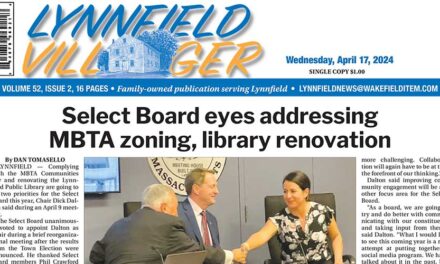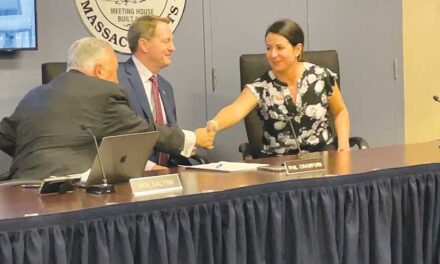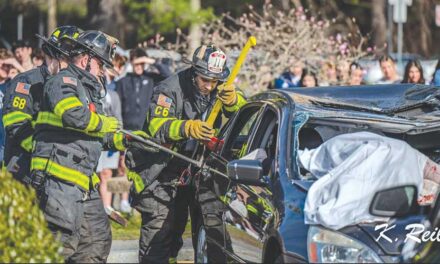Published April 10, 2019
By DAN TOMASELLO
LYNNFIELD — Developer Angus Bruce made the case for a proposed elderly housing development in front of 20 residents during an April 3 community forum held at the Meeting House.
Attorney Jay Kimball submitted Article 16 on behalf of Bruce. Article 16 seeks to rezone a parcel of land on upper Main Street from Residence D to Elderly Housing for the purpose of constructing the Woods of Lynnfield elderly housing development. A two-thirds majority will be required to approve the zoning change at Town Meeting.
Kimball said the Woods of Lynnfield project entails constructing 33 duplexes as part of a 55-and-over development. He said the 66 units will each have two bedrooms, and each unit will have a two-car garage. Bruce added that one of the units will be designated for a veteran.
“It will be affordable,” said Bruce about the veteran’s unit. “I wasn’t required to do that, but it’s something I wanted to do.”
Bruce noted that the proposed development is setback 400 feet from Main Street.
“Main Street will look the same as it is now,” said Bruce. “You won’t be driving by and seeing a subdivision.”
While Bruce noted the proposed Woods of Lynnfield development is near the Sagamore Spring Golf Course, he said the duplexes would not be built on the course. Developer Ron Bonvie proposed constructing an elderly housing development on Sagamore’s eastern side during the April 2018 Town Meeting, but that warrant article did not pass after it failed to receive a two-thirds majority.
In addition to residents voting on Article 16 at the April 29 Town Meeting, Bruce said Article 15 would amend the town’s Zoning Bylaw. As a result, he said the Planning Board will be able to issue a Special Permit for elderly housing developments.
“(Article 15) will allow this project to come under the Planning Board’s purview,” said Bruce. “If you decide to vote for this project, I will have to go through a whole process.”
Bruce has met with Fire Chief Glenn Davis and Police Chief David Breen to discuss the project and their possible concerns. He plans on meeting with public safety officials if the project is approved.
The development would be overseen by a condo association, which would be responsible for road maintenance, snow plowing and trash collection.
“There is no cost to the town,” Bruce. “This is not a town road.”
Bruce said each of the development’s units would each cost around $589,900, and would generate $608,850 in tax revenue. He has also agreed to pay a “betterment tax,” which Bruce said involves paying the town $10,000 per unit. If the project moves forward, he said the town would receive $650,000.
If Town Meeting rejects Article 16, Bruce said 15 homes would be built on the 22.6-acre property. He projects around 40 children will live in the subdivision, and said it would cost $15,205 to educate each child in the school system. He also said the town would be on the hook for road repairs, plowing and trash collection costs.
“A 15-lot subdivision would cost the town $224,614 each year,” said Bruce.
Morin-Cameron Group principal owner/engineer Scott Cameron said there is a growing demand for senior housing.
“We want to create housing for the elderly,” said Cameron. “That is why we are going before Town Meeting in a few weeks to request changing the zoning district from Residential to Elderly Housing. The other option would be single-family housing, but we feel this is a better suited project for the property.”
Cameron said the project would comply with the Zoning Bylaw, and would be reviewed by the Planning Board. He said the development would have a circular design that would be surrounded by trees.
“The idea is to have preserved woods around every single unit to create the feeling of a smaller development,” said Cameron. “You won’t be able to see the property from the street.”
Cameron said the Massachusetts Department of Environmental Protection has signed off on “site approval” for three community wells that would provide water to the Woods of Lynnfield development. He said MassDEP will monitor the wells.
“These wells would serve as the development’s water supply and also fire protection supply,” said Cameron.
GPI Assistant Vice President Heather Monticup noted a preliminary traffic study has been conducted in advance of Town Meeting. She said the project would generate less traffic than a residential development.
“There will be a minimal impact on Main Street as a result of this development,” said Monticup.
If the project moves forward, Monticup said a more comprehensive traffic study will be undertaken once Sagamore is up and running for the season.
Bruce encouraged the meeting’s attendees to vote for Article 16.
“We spent a lot of time trying to make sure this wouldn’t have any major change to the town that is negative,” said Bruce. “We think this project would be positive. I know that sounds a little self-serving as a developer, but I have really made that effort.”
Residents’ weigh in
After the development team concluded its presentation, attendees were given an opportunity to ask questions. Two residents expressed their opposition to the proposed development.
In response to a question from a man in the audience, Cameron said the roadway’s width will be 20-feet.
“The regulations in the bylaw require a 20-foot wide road,” said Cameron. “That meets the State Fire Marshall’s Office standard for width for fire access. We will be working with the fire chief on that to see if we need more or less in certain areas.”
A woman inquired who would be responsible for overseeing the development.
Bruce said a condo association will oversee the property. He projects condo fees will range between $300 and $350 per month. He said he did not include a clubhouse as part of the development in order to “keep the costs down.”
Merrow Road resident Ken MacNulty inquired what the project’s impact will be on the Lynnfield Center Water District.
Bruce said the three community wells will be separate from the LCWD. He said the wells will be monitored and regulated by MassDEP.
“We will have to go through a process with the condo association,” said Bruce. “They will be required to monitor how much water they draw. They will be restricted not to go over the amount allotted, which will be 9,900 gallons per day. There is a very significant penalty and DEP does enforce it. DEP is very, very restrict. If they go over that amount, they will get fined. We are going to go through an exhaustive process to make sure it doesn’t have any impact on any surrounding wells. I reached out to the Lynnfield Center Water District to tell them what we are doing, and I will keep them apprised of what we are doing.”
A woman expressed concerns about the development’s narrow street.
Cameron noted the development will have a guest parking lot. He said residents who fail to abide by the condo association’s parking rules will be fined. He said the road will be designed to accommodate public safety vehicles including fire trucks.
Bruce said he doesn’t anticipate too many parking issues.
“We are going to have older people here,” said Bruce. “Everybody won’t be 55 and partying.”
Patrice Lane resident Pat Campbell noted Bruce is also developing a subdivision on a new street called Sagamore Place, which is close to receiving final approval from the Planning Board. She inquired what will happen if Town Meeting rejects the development.
“If the zoning is turned down, then I would probably combine the two projects,” said Bruce. “The five-lot subdivision has not gone away. It’s just sitting at the moment. If it turns out that people don’t like the 66 units, then I would combine the five and the balance in the back of the property and make a big subdivision.”
Campbell expressed concerns about the development’s impact on Main Street traffic.
“When you are retired, you make more trips a day, not less,” said Campbell. “I went on a trip and I had to be at the Senior Center no later than 8:15 a.m. And I had trouble getting out of my driveway because there is so much traffic flowing. We need a valid study.”
Main Street resident Ken Peterson blasted the project because he said the development would have a negative impact on traffic in the area.
“I have lived on upper Main Street for 40 years,” said Peterson. “I am well aware of why we need two acres of single-family homes. This is one of the most dangerous roads in the state. It has double curvage, so I can’t see over the hump and around the bend. We have numerous accidents on upper Main Street due to the steep downgrade and curvage. That is why we support maintaining two-acre single-family homes. This is a great idea, but put it somewhere where the road is flat.”
Kimball noted Article 16 would simply rezone the property from Residence D to Elderly Housing.
“That would be the only impact of your vote at Town Meeting,” said Kimball. “Thereafter, all of the process has to go through site plan approval, which has public hearings and notices sent to abutters. You will have the opportunity to see the actual plans get developed once the re-zoning is allowed.”
Bruce agreed.
“What you see is not a guarantee,” said Bruce. “I could end up with a lot less.”




